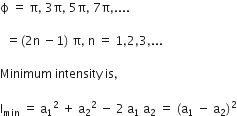 Long Answer Type
Long Answer Type(a) Explain, giving reasons, the basic difference in converting a galvanometer into (i) a voltmeter and (ii) an ammeter.
(b) Two long straight parallel conductors carrying steady current I1 and I2 are separated by a distance ‘d’. Explain briefly, with the help of a suitable diagram, how the magnetic field due to one conductor acts on the other. Hence deduce the expression for the force acting between the conductors. Mention the nature of this force.a) In Young’s double slit experiment, derive the condition for (i) constructive interference and
(ii) Destructive interference at a point on the screen.
(b) A beam of light consisting of two wavelengths, 800 nm and 600 nm is used to obtain the interference fringes in a Young’s double slit experiment on a screen placed 1.4 m away. If the two slits are separated by 0.28 mm, calculate the least distance from the central bright maximum where the bright fringes of the two wavelengths coincide.
a)
Conditions of constructive interference and destructive interference.
Consider two coherent waves travelling in the same direction along a straight line.
Frequency of each wave is given by ![]() ,
,
Amplitude of electric field vectors are a1 and a2 rspectively.
Wave equation is represented by, 

Intensity of the wave is proportional to the amplitude of the wave.
Thus, Intensity of the resultant wave is given by, ![]()
Constructive interference: For maximum intensity at any point, cos = +1![]()
So, maximum intensity is, ![]()
Path difference is, 
Constructive interference is obtained when the path difference between the waves is an integral multiple of ![]()
Destructive Interference: For minimum intensity at any point, cos = -1
Phase difference is given by, 
Path difference is, 
In destructive interference, path difference is odd multiple of ![]() .
.
b)
Given,
d = 0.28 mm = 0.28 x 10-3 m
As, ![]()
If n1 = n then, n2 = n+1![]()


(a) How does an unpolarized light incident on a Polaroid get polarized?
Describe briefly, with the help of a necessary diagram, the polarization of light by reflection from a transparent medium.
(b) Two Polaroid’s ‘A’ and ‘B’ are kept in crossed position. How should a third Polaroid ‘C’ be placed between them so that the intensity of polarized light transmitted by Polaroid B reduces to 1/8th of the intensity of unpolarized light incident on A?(a) Describe briefly, with the help of a diagram, the role of the two important processes involved in the formation of a p-n junction.
(b) Name the device which is used as a voltage-regulator. Draw the necessary circuit diagram and explain its working.
OR
(a) Explain briefly the principle on which a transistor-amplifier works as an oscillator. Draw the necessary circuit diagram and explain its working.
(b) Identify the equivalent gate for the following circuit and write its truth table.
